Behavior Modification Techniques: Applying MI to Smoking Cessation
VerifiedAdded on 2023/06/14
|10
|2081
|295
Essay
AI Summary
This essay discusses the application of behavior modification techniques in mental health therapy, particularly focusing on substance abuse treatment. It utilizes the Trans-theoretical Model of change and motivational interviewing (MI) to address behavioral aspects that could harm a patient. The essay analyzes a case study of a 35-year-old male, Ying, who seeks to quit smoking, highlighting the stages of change and the components of MI such as giving advice, removing barriers, providing choice, decreasing desirability, practicing empathy, providing feedback, clarifying goals, and active helping. It also addresses the five principles of MI to create conditions for change and discusses the challenges, including patient resistance, and concludes by referencing a story of overcoming mental illness through creativity. Desklib provides this essay as a resource for students studying these concepts.
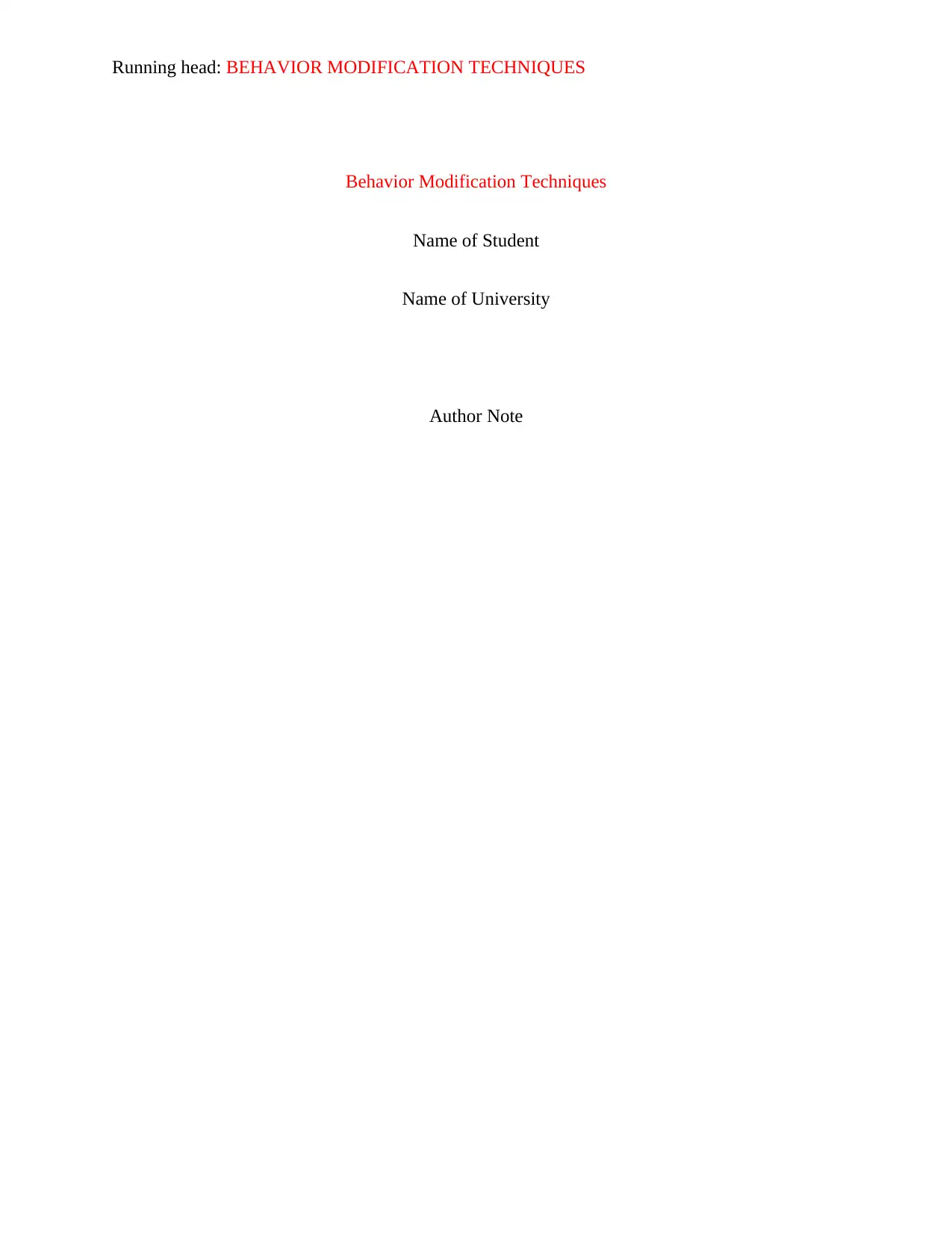
Running head: BEHAVIOR MODIFICATION TECHNIQUES
Behavior Modification Techniques
Name of Student
Name of University
Author Note
Behavior Modification Techniques
Name of Student
Name of University
Author Note
Paraphrase This Document
Need a fresh take? Get an instant paraphrase of this document with our AI Paraphraser
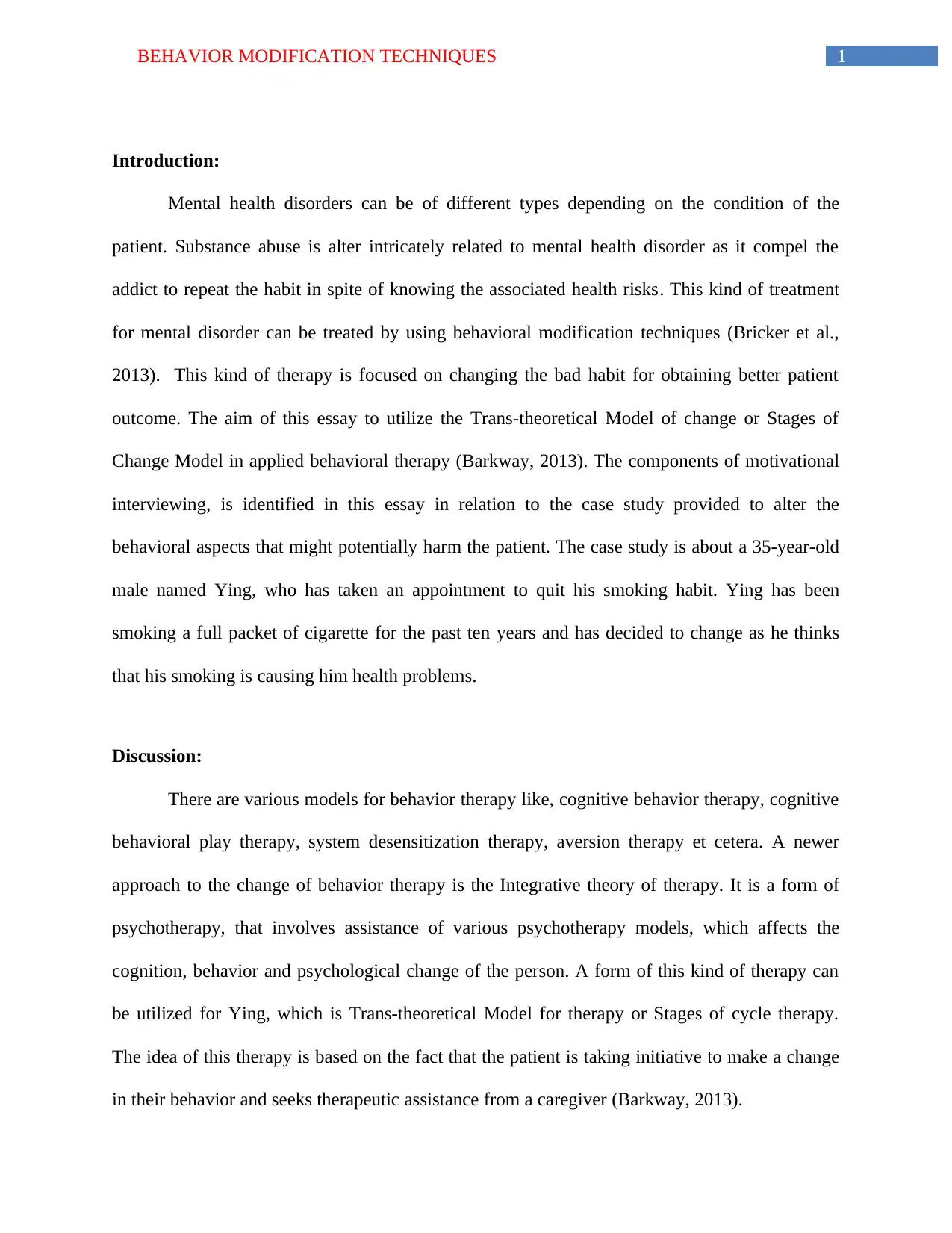
1BEHAVIOR MODIFICATION TECHNIQUES
Introduction:
Mental health disorders can be of different types depending on the condition of the
patient. Substance abuse is alter intricately related to mental health disorder as it compel the
addict to repeat the habit in spite of knowing the associated health risks. This kind of treatment
for mental disorder can be treated by using behavioral modification techniques (Bricker et al.,
2013). This kind of therapy is focused on changing the bad habit for obtaining better patient
outcome. The aim of this essay to utilize the Trans-theoretical Model of change or Stages of
Change Model in applied behavioral therapy (Barkway, 2013). The components of motivational
interviewing, is identified in this essay in relation to the case study provided to alter the
behavioral aspects that might potentially harm the patient. The case study is about a 35-year-old
male named Ying, who has taken an appointment to quit his smoking habit. Ying has been
smoking a full packet of cigarette for the past ten years and has decided to change as he thinks
that his smoking is causing him health problems.
Discussion:
There are various models for behavior therapy like, cognitive behavior therapy, cognitive
behavioral play therapy, system desensitization therapy, aversion therapy et cetera. A newer
approach to the change of behavior therapy is the Integrative theory of therapy. It is a form of
psychotherapy, that involves assistance of various psychotherapy models, which affects the
cognition, behavior and psychological change of the person. A form of this kind of therapy can
be utilized for Ying, which is Trans-theoretical Model for therapy or Stages of cycle therapy.
The idea of this therapy is based on the fact that the patient is taking initiative to make a change
in their behavior and seeks therapeutic assistance from a caregiver (Barkway, 2013).
Introduction:
Mental health disorders can be of different types depending on the condition of the
patient. Substance abuse is alter intricately related to mental health disorder as it compel the
addict to repeat the habit in spite of knowing the associated health risks. This kind of treatment
for mental disorder can be treated by using behavioral modification techniques (Bricker et al.,
2013). This kind of therapy is focused on changing the bad habit for obtaining better patient
outcome. The aim of this essay to utilize the Trans-theoretical Model of change or Stages of
Change Model in applied behavioral therapy (Barkway, 2013). The components of motivational
interviewing, is identified in this essay in relation to the case study provided to alter the
behavioral aspects that might potentially harm the patient. The case study is about a 35-year-old
male named Ying, who has taken an appointment to quit his smoking habit. Ying has been
smoking a full packet of cigarette for the past ten years and has decided to change as he thinks
that his smoking is causing him health problems.
Discussion:
There are various models for behavior therapy like, cognitive behavior therapy, cognitive
behavioral play therapy, system desensitization therapy, aversion therapy et cetera. A newer
approach to the change of behavior therapy is the Integrative theory of therapy. It is a form of
psychotherapy, that involves assistance of various psychotherapy models, which affects the
cognition, behavior and psychological change of the person. A form of this kind of therapy can
be utilized for Ying, which is Trans-theoretical Model for therapy or Stages of cycle therapy.
The idea of this therapy is based on the fact that the patient is taking initiative to make a change
in their behavior and seeks therapeutic assistance from a caregiver (Barkway, 2013).
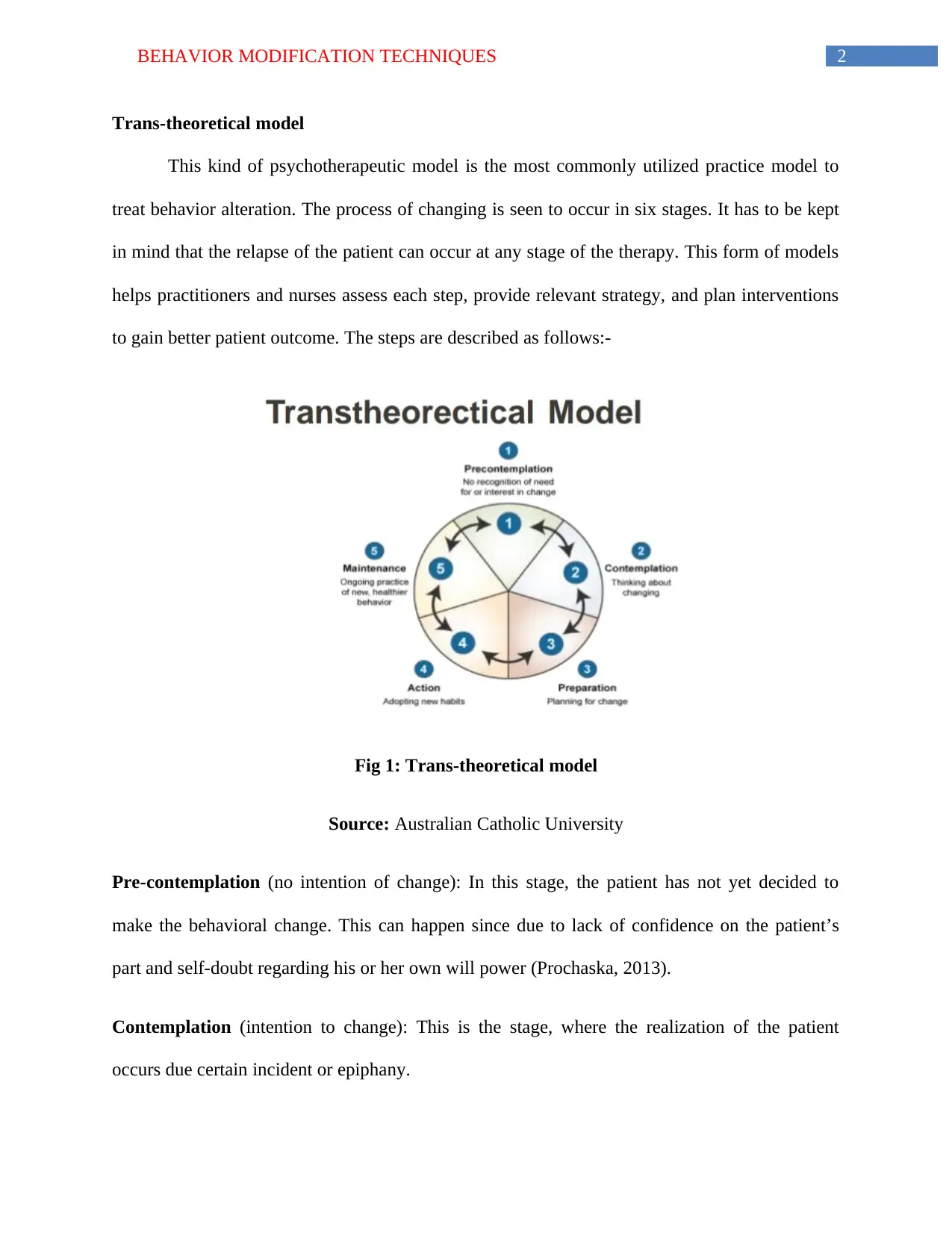
2BEHAVIOR MODIFICATION TECHNIQUES
Trans-theoretical model
This kind of psychotherapeutic model is the most commonly utilized practice model to
treat behavior alteration. The process of changing is seen to occur in six stages. It has to be kept
in mind that the relapse of the patient can occur at any stage of the therapy. This form of models
helps practitioners and nurses assess each step, provide relevant strategy, and plan interventions
to gain better patient outcome. The steps are described as follows:-
Fig 1: Trans-theoretical model
Source: Australian Catholic University
Pre-contemplation (no intention of change): In this stage, the patient has not yet decided to
make the behavioral change. This can happen since due to lack of confidence on the patient’s
part and self-doubt regarding his or her own will power (Prochaska, 2013).
Contemplation (intention to change): This is the stage, where the realization of the patient
occurs due certain incident or epiphany.
Trans-theoretical model
This kind of psychotherapeutic model is the most commonly utilized practice model to
treat behavior alteration. The process of changing is seen to occur in six stages. It has to be kept
in mind that the relapse of the patient can occur at any stage of the therapy. This form of models
helps practitioners and nurses assess each step, provide relevant strategy, and plan interventions
to gain better patient outcome. The steps are described as follows:-
Fig 1: Trans-theoretical model
Source: Australian Catholic University
Pre-contemplation (no intention of change): In this stage, the patient has not yet decided to
make the behavioral change. This can happen since due to lack of confidence on the patient’s
part and self-doubt regarding his or her own will power (Prochaska, 2013).
Contemplation (intention to change): This is the stage, where the realization of the patient
occurs due certain incident or epiphany.
⊘ This is a preview!⊘
Do you want full access?
Subscribe today to unlock all pages.

Trusted by 1+ million students worldwide
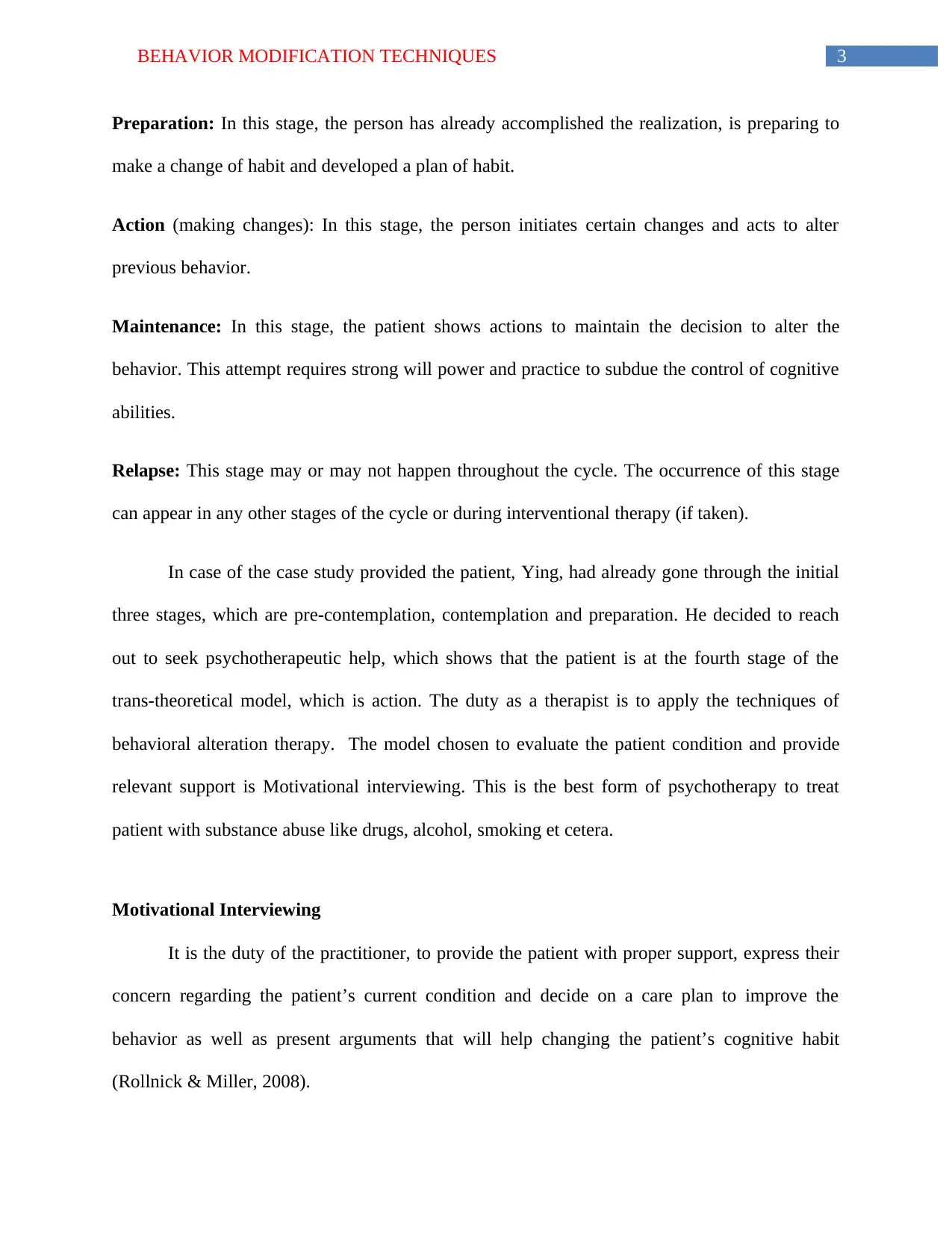
3BEHAVIOR MODIFICATION TECHNIQUES
Preparation: In this stage, the person has already accomplished the realization, is preparing to
make a change of habit and developed a plan of habit.
Action (making changes): In this stage, the person initiates certain changes and acts to alter
previous behavior.
Maintenance: In this stage, the patient shows actions to maintain the decision to alter the
behavior. This attempt requires strong will power and practice to subdue the control of cognitive
abilities.
Relapse: This stage may or may not happen throughout the cycle. The occurrence of this stage
can appear in any other stages of the cycle or during interventional therapy (if taken).
In case of the case study provided the patient, Ying, had already gone through the initial
three stages, which are pre-contemplation, contemplation and preparation. He decided to reach
out to seek psychotherapeutic help, which shows that the patient is at the fourth stage of the
trans-theoretical model, which is action. The duty as a therapist is to apply the techniques of
behavioral alteration therapy. The model chosen to evaluate the patient condition and provide
relevant support is Motivational interviewing. This is the best form of psychotherapy to treat
patient with substance abuse like drugs, alcohol, smoking et cetera.
Motivational Interviewing
It is the duty of the practitioner, to provide the patient with proper support, express their
concern regarding the patient’s current condition and decide on a care plan to improve the
behavior as well as present arguments that will help changing the patient’s cognitive habit
(Rollnick & Miller, 2008).
Preparation: In this stage, the person has already accomplished the realization, is preparing to
make a change of habit and developed a plan of habit.
Action (making changes): In this stage, the person initiates certain changes and acts to alter
previous behavior.
Maintenance: In this stage, the patient shows actions to maintain the decision to alter the
behavior. This attempt requires strong will power and practice to subdue the control of cognitive
abilities.
Relapse: This stage may or may not happen throughout the cycle. The occurrence of this stage
can appear in any other stages of the cycle or during interventional therapy (if taken).
In case of the case study provided the patient, Ying, had already gone through the initial
three stages, which are pre-contemplation, contemplation and preparation. He decided to reach
out to seek psychotherapeutic help, which shows that the patient is at the fourth stage of the
trans-theoretical model, which is action. The duty as a therapist is to apply the techniques of
behavioral alteration therapy. The model chosen to evaluate the patient condition and provide
relevant support is Motivational interviewing. This is the best form of psychotherapy to treat
patient with substance abuse like drugs, alcohol, smoking et cetera.
Motivational Interviewing
It is the duty of the practitioner, to provide the patient with proper support, express their
concern regarding the patient’s current condition and decide on a care plan to improve the
behavior as well as present arguments that will help changing the patient’s cognitive habit
(Rollnick & Miller, 2008).
Paraphrase This Document
Need a fresh take? Get an instant paraphrase of this document with our AI Paraphraser
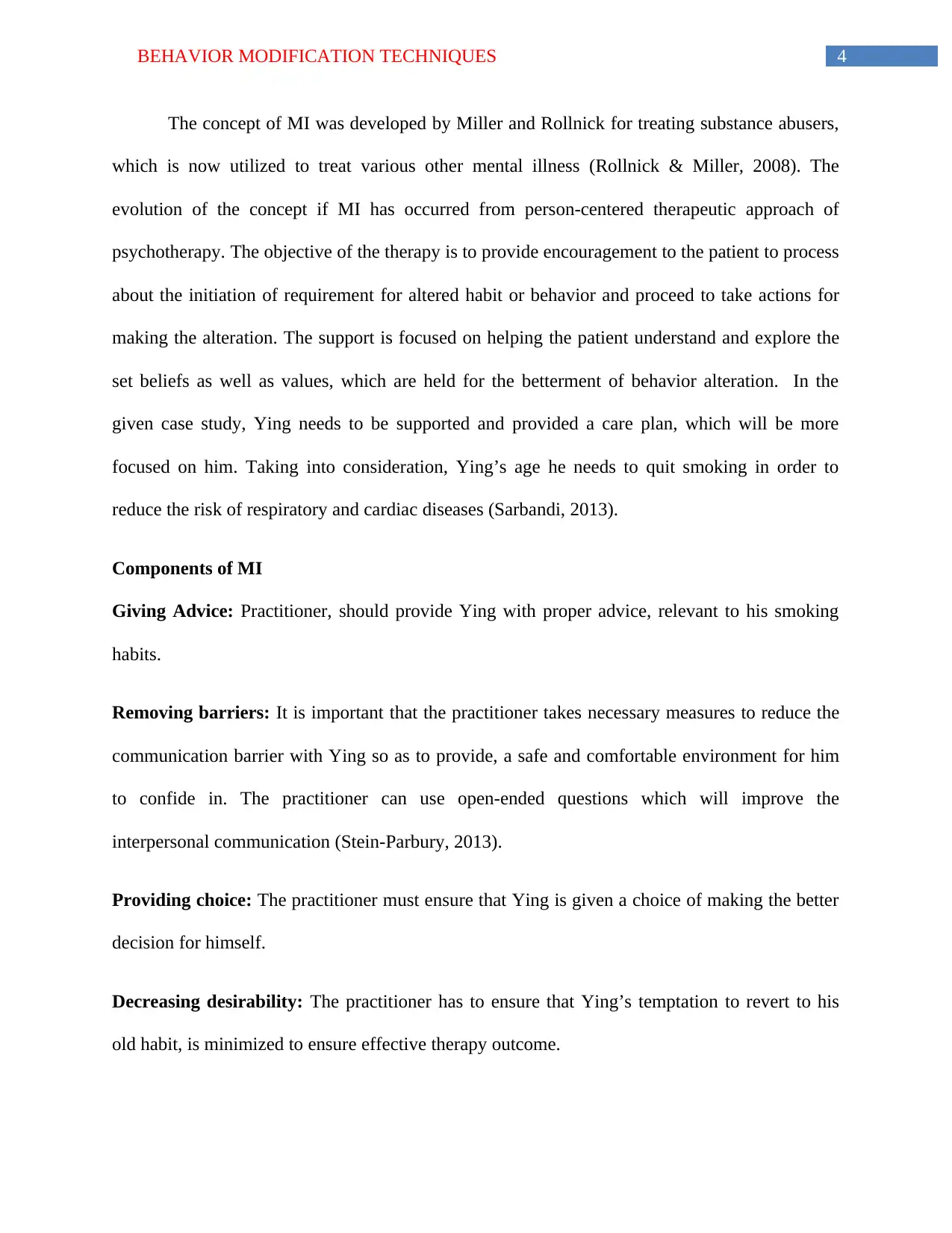
4BEHAVIOR MODIFICATION TECHNIQUES
The concept of MI was developed by Miller and Rollnick for treating substance abusers,
which is now utilized to treat various other mental illness (Rollnick & Miller, 2008). The
evolution of the concept if MI has occurred from person-centered therapeutic approach of
psychotherapy. The objective of the therapy is to provide encouragement to the patient to process
about the initiation of requirement for altered habit or behavior and proceed to take actions for
making the alteration. The support is focused on helping the patient understand and explore the
set beliefs as well as values, which are held for the betterment of behavior alteration. In the
given case study, Ying needs to be supported and provided a care plan, which will be more
focused on him. Taking into consideration, Ying’s age he needs to quit smoking in order to
reduce the risk of respiratory and cardiac diseases (Sarbandi, 2013).
Components of MI
Giving Advice: Practitioner, should provide Ying with proper advice, relevant to his smoking
habits.
Removing barriers: It is important that the practitioner takes necessary measures to reduce the
communication barrier with Ying so as to provide, a safe and comfortable environment for him
to confide in. The practitioner can use open-ended questions which will improve the
interpersonal communication (Stein-Parbury, 2013).
Providing choice: The practitioner must ensure that Ying is given a choice of making the better
decision for himself.
Decreasing desirability: The practitioner has to ensure that Ying’s temptation to revert to his
old habit, is minimized to ensure effective therapy outcome.
The concept of MI was developed by Miller and Rollnick for treating substance abusers,
which is now utilized to treat various other mental illness (Rollnick & Miller, 2008). The
evolution of the concept if MI has occurred from person-centered therapeutic approach of
psychotherapy. The objective of the therapy is to provide encouragement to the patient to process
about the initiation of requirement for altered habit or behavior and proceed to take actions for
making the alteration. The support is focused on helping the patient understand and explore the
set beliefs as well as values, which are held for the betterment of behavior alteration. In the
given case study, Ying needs to be supported and provided a care plan, which will be more
focused on him. Taking into consideration, Ying’s age he needs to quit smoking in order to
reduce the risk of respiratory and cardiac diseases (Sarbandi, 2013).
Components of MI
Giving Advice: Practitioner, should provide Ying with proper advice, relevant to his smoking
habits.
Removing barriers: It is important that the practitioner takes necessary measures to reduce the
communication barrier with Ying so as to provide, a safe and comfortable environment for him
to confide in. The practitioner can use open-ended questions which will improve the
interpersonal communication (Stein-Parbury, 2013).
Providing choice: The practitioner must ensure that Ying is given a choice of making the better
decision for himself.
Decreasing desirability: The practitioner has to ensure that Ying’s temptation to revert to his
old habit, is minimized to ensure effective therapy outcome.
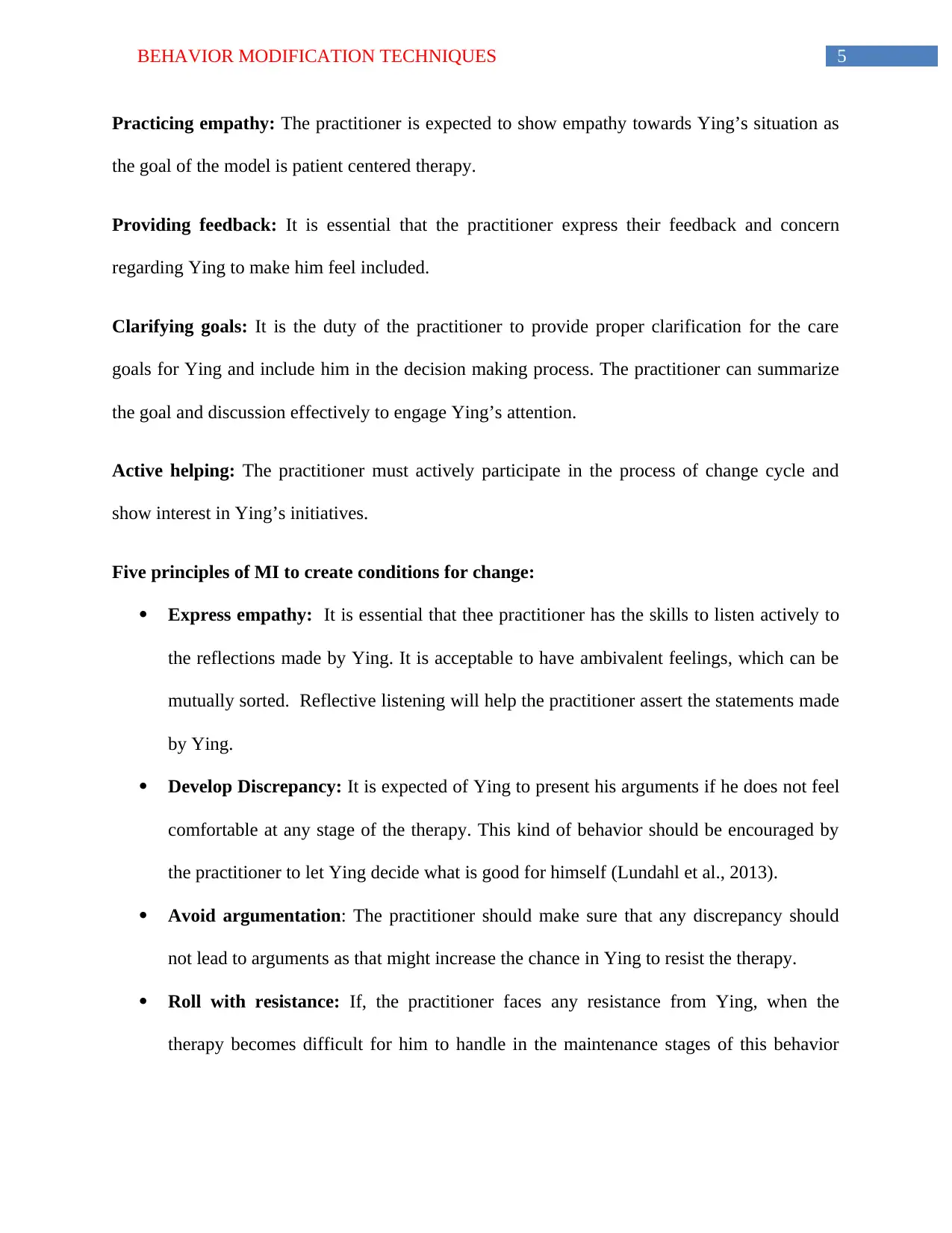
5BEHAVIOR MODIFICATION TECHNIQUES
Practicing empathy: The practitioner is expected to show empathy towards Ying’s situation as
the goal of the model is patient centered therapy.
Providing feedback: It is essential that the practitioner express their feedback and concern
regarding Ying to make him feel included.
Clarifying goals: It is the duty of the practitioner to provide proper clarification for the care
goals for Ying and include him in the decision making process. The practitioner can summarize
the goal and discussion effectively to engage Ying’s attention.
Active helping: The practitioner must actively participate in the process of change cycle and
show interest in Ying’s initiatives.
Five principles of MI to create conditions for change:
Express empathy: It is essential that thee practitioner has the skills to listen actively to
the reflections made by Ying. It is acceptable to have ambivalent feelings, which can be
mutually sorted. Reflective listening will help the practitioner assert the statements made
by Ying.
Develop Discrepancy: It is expected of Ying to present his arguments if he does not feel
comfortable at any stage of the therapy. This kind of behavior should be encouraged by
the practitioner to let Ying decide what is good for himself (Lundahl et al., 2013).
Avoid argumentation: The practitioner should make sure that any discrepancy should
not lead to arguments as that might increase the chance in Ying to resist the therapy.
Roll with resistance: If, the practitioner faces any resistance from Ying, when the
therapy becomes difficult for him to handle in the maintenance stages of this behavior
Practicing empathy: The practitioner is expected to show empathy towards Ying’s situation as
the goal of the model is patient centered therapy.
Providing feedback: It is essential that the practitioner express their feedback and concern
regarding Ying to make him feel included.
Clarifying goals: It is the duty of the practitioner to provide proper clarification for the care
goals for Ying and include him in the decision making process. The practitioner can summarize
the goal and discussion effectively to engage Ying’s attention.
Active helping: The practitioner must actively participate in the process of change cycle and
show interest in Ying’s initiatives.
Five principles of MI to create conditions for change:
Express empathy: It is essential that thee practitioner has the skills to listen actively to
the reflections made by Ying. It is acceptable to have ambivalent feelings, which can be
mutually sorted. Reflective listening will help the practitioner assert the statements made
by Ying.
Develop Discrepancy: It is expected of Ying to present his arguments if he does not feel
comfortable at any stage of the therapy. This kind of behavior should be encouraged by
the practitioner to let Ying decide what is good for himself (Lundahl et al., 2013).
Avoid argumentation: The practitioner should make sure that any discrepancy should
not lead to arguments as that might increase the chance in Ying to resist the therapy.
Roll with resistance: If, the practitioner faces any resistance from Ying, when the
therapy becomes difficult for him to handle in the maintenance stages of this behavior
⊘ This is a preview!⊘
Do you want full access?
Subscribe today to unlock all pages.

Trusted by 1+ million students worldwide
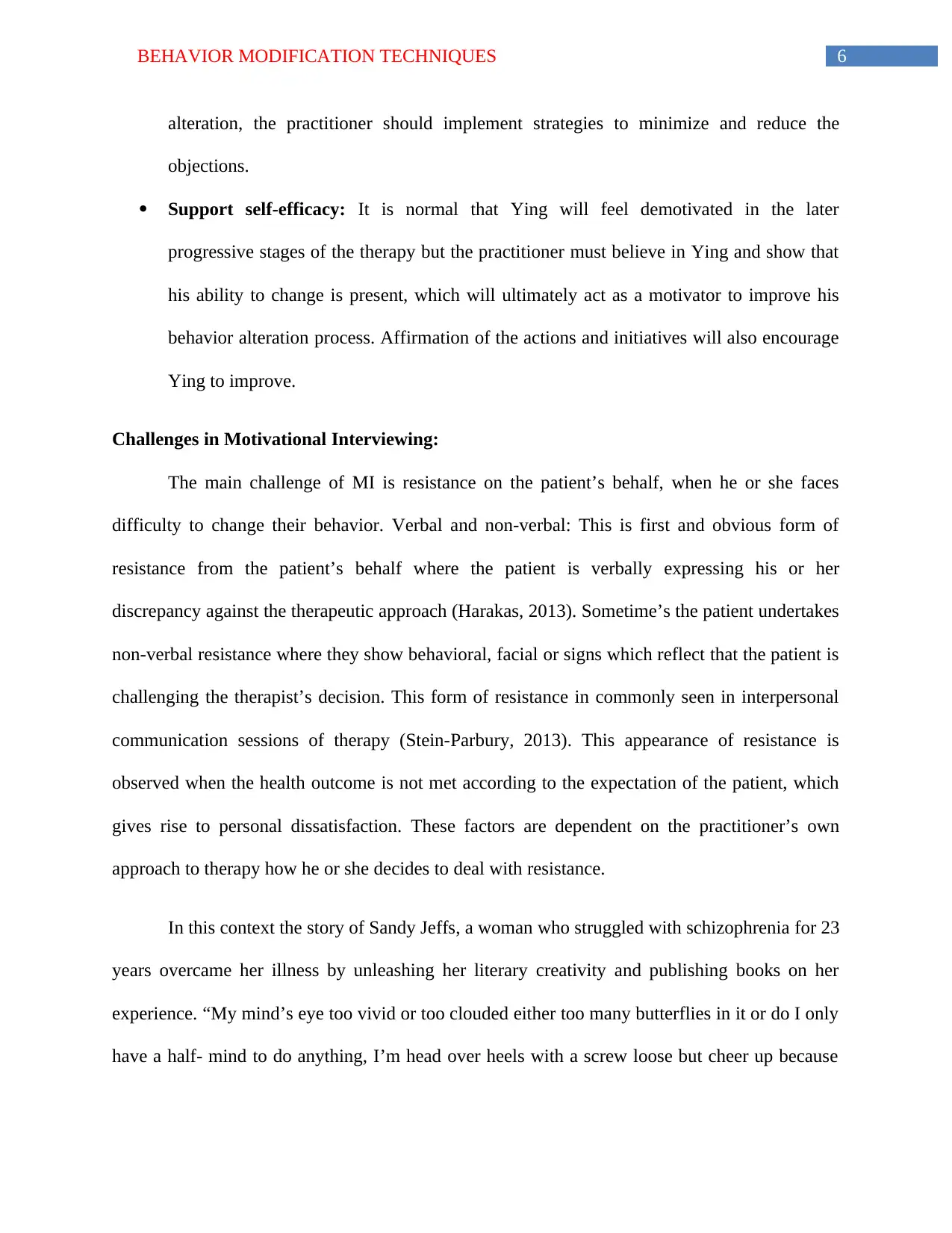
6BEHAVIOR MODIFICATION TECHNIQUES
alteration, the practitioner should implement strategies to minimize and reduce the
objections.
Support self-efficacy: It is normal that Ying will feel demotivated in the later
progressive stages of the therapy but the practitioner must believe in Ying and show that
his ability to change is present, which will ultimately act as a motivator to improve his
behavior alteration process. Affirmation of the actions and initiatives will also encourage
Ying to improve.
Challenges in Motivational Interviewing:
The main challenge of MI is resistance on the patient’s behalf, when he or she faces
difficulty to change their behavior. Verbal and non-verbal: This is first and obvious form of
resistance from the patient’s behalf where the patient is verbally expressing his or her
discrepancy against the therapeutic approach (Harakas, 2013). Sometime’s the patient undertakes
non-verbal resistance where they show behavioral, facial or signs which reflect that the patient is
challenging the therapist’s decision. This form of resistance in commonly seen in interpersonal
communication sessions of therapy (Stein-Parbury, 2013). This appearance of resistance is
observed when the health outcome is not met according to the expectation of the patient, which
gives rise to personal dissatisfaction. These factors are dependent on the practitioner’s own
approach to therapy how he or she decides to deal with resistance.
In this context the story of Sandy Jeffs, a woman who struggled with schizophrenia for 23
years overcame her illness by unleashing her literary creativity and publishing books on her
experience. “My mind’s eye too vivid or too clouded either too many butterflies in it or do I only
have a half- mind to do anything, I’m head over heels with a screw loose but cheer up because
alteration, the practitioner should implement strategies to minimize and reduce the
objections.
Support self-efficacy: It is normal that Ying will feel demotivated in the later
progressive stages of the therapy but the practitioner must believe in Ying and show that
his ability to change is present, which will ultimately act as a motivator to improve his
behavior alteration process. Affirmation of the actions and initiatives will also encourage
Ying to improve.
Challenges in Motivational Interviewing:
The main challenge of MI is resistance on the patient’s behalf, when he or she faces
difficulty to change their behavior. Verbal and non-verbal: This is first and obvious form of
resistance from the patient’s behalf where the patient is verbally expressing his or her
discrepancy against the therapeutic approach (Harakas, 2013). Sometime’s the patient undertakes
non-verbal resistance where they show behavioral, facial or signs which reflect that the patient is
challenging the therapist’s decision. This form of resistance in commonly seen in interpersonal
communication sessions of therapy (Stein-Parbury, 2013). This appearance of resistance is
observed when the health outcome is not met according to the expectation of the patient, which
gives rise to personal dissatisfaction. These factors are dependent on the practitioner’s own
approach to therapy how he or she decides to deal with resistance.
In this context the story of Sandy Jeffs, a woman who struggled with schizophrenia for 23
years overcame her illness by unleashing her literary creativity and publishing books on her
experience. “My mind’s eye too vivid or too clouded either too many butterflies in it or do I only
have a half- mind to do anything, I’m head over heels with a screw loose but cheer up because
Paraphrase This Document
Need a fresh take? Get an instant paraphrase of this document with our AI Paraphraser

7BEHAVIOR MODIFICATION TECHNIQUES
every mad clown has a sane lining or does every sane cloud have a mad lining, the mad
boggles...”
every mad clown has a sane lining or does every sane cloud have a mad lining, the mad
boggles...”
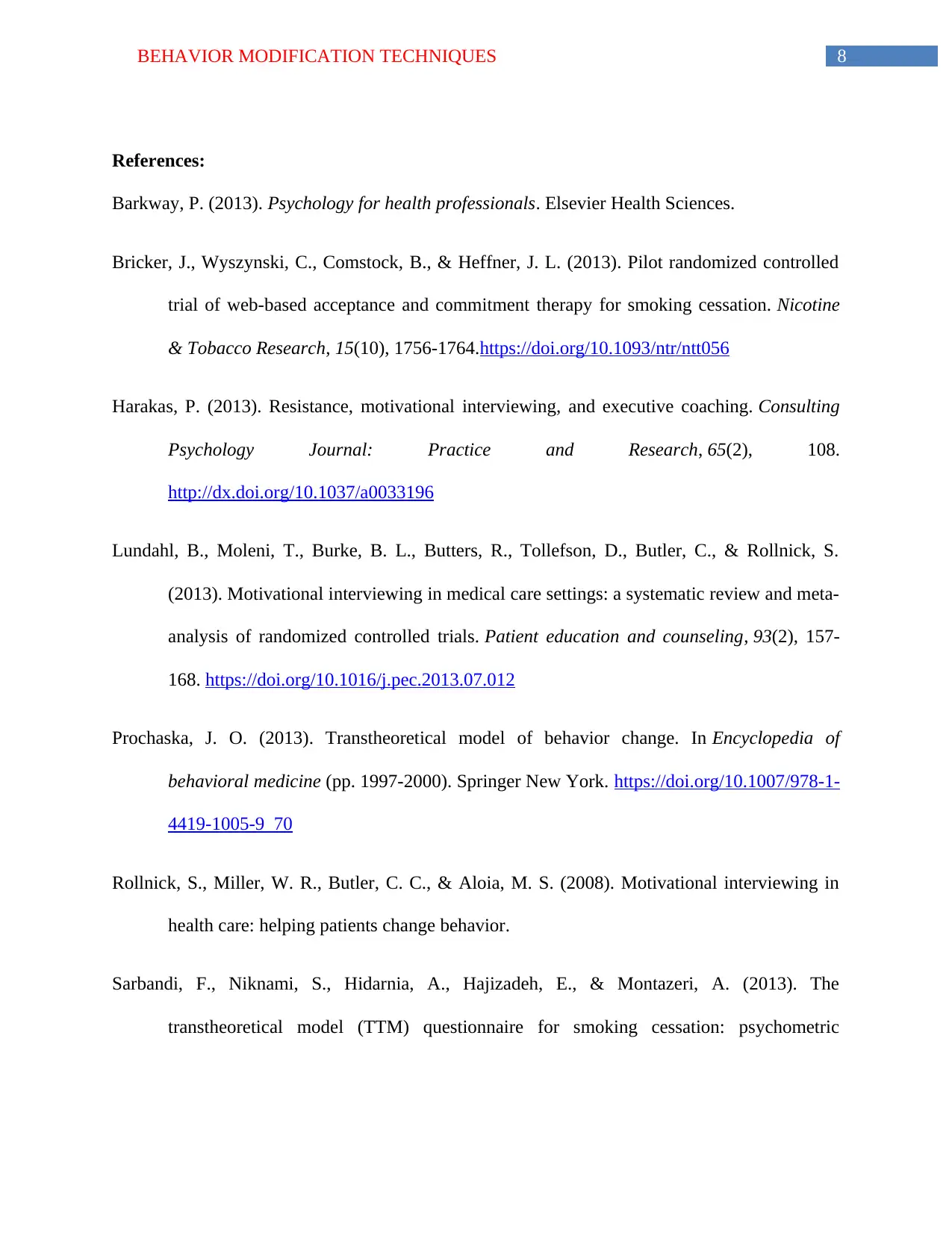
8BEHAVIOR MODIFICATION TECHNIQUES
References:
Barkway, P. (2013). Psychology for health professionals. Elsevier Health Sciences.
Bricker, J., Wyszynski, C., Comstock, B., & Heffner, J. L. (2013). Pilot randomized controlled
trial of web-based acceptance and commitment therapy for smoking cessation. Nicotine
& Tobacco Research, 15(10), 1756-1764.https://doi.org/10.1093/ntr/ntt056
Harakas, P. (2013). Resistance, motivational interviewing, and executive coaching. Consulting
Psychology Journal: Practice and Research, 65(2), 108.
http://dx.doi.org/10.1037/a0033196
Lundahl, B., Moleni, T., Burke, B. L., Butters, R., Tollefson, D., Butler, C., & Rollnick, S.
(2013). Motivational interviewing in medical care settings: a systematic review and meta-
analysis of randomized controlled trials. Patient education and counseling, 93(2), 157-
168. https://doi.org/10.1016/j.pec.2013.07.012
Prochaska, J. O. (2013). Transtheoretical model of behavior change. In Encyclopedia of
behavioral medicine (pp. 1997-2000). Springer New York. https://doi.org/10.1007/978-1-
4419-1005-9_70
Rollnick, S., Miller, W. R., Butler, C. C., & Aloia, M. S. (2008). Motivational interviewing in
health care: helping patients change behavior.
Sarbandi, F., Niknami, S., Hidarnia, A., Hajizadeh, E., & Montazeri, A. (2013). The
transtheoretical model (TTM) questionnaire for smoking cessation: psychometric
References:
Barkway, P. (2013). Psychology for health professionals. Elsevier Health Sciences.
Bricker, J., Wyszynski, C., Comstock, B., & Heffner, J. L. (2013). Pilot randomized controlled
trial of web-based acceptance and commitment therapy for smoking cessation. Nicotine
& Tobacco Research, 15(10), 1756-1764.https://doi.org/10.1093/ntr/ntt056
Harakas, P. (2013). Resistance, motivational interviewing, and executive coaching. Consulting
Psychology Journal: Practice and Research, 65(2), 108.
http://dx.doi.org/10.1037/a0033196
Lundahl, B., Moleni, T., Burke, B. L., Butters, R., Tollefson, D., Butler, C., & Rollnick, S.
(2013). Motivational interviewing in medical care settings: a systematic review and meta-
analysis of randomized controlled trials. Patient education and counseling, 93(2), 157-
168. https://doi.org/10.1016/j.pec.2013.07.012
Prochaska, J. O. (2013). Transtheoretical model of behavior change. In Encyclopedia of
behavioral medicine (pp. 1997-2000). Springer New York. https://doi.org/10.1007/978-1-
4419-1005-9_70
Rollnick, S., Miller, W. R., Butler, C. C., & Aloia, M. S. (2008). Motivational interviewing in
health care: helping patients change behavior.
Sarbandi, F., Niknami, S., Hidarnia, A., Hajizadeh, E., & Montazeri, A. (2013). The
transtheoretical model (TTM) questionnaire for smoking cessation: psychometric
⊘ This is a preview!⊘
Do you want full access?
Subscribe today to unlock all pages.

Trusted by 1+ million students worldwide

9BEHAVIOR MODIFICATION TECHNIQUES
properties of the Iranian version. BMC public health, 13(1),
1186.https://doi.org/10.1186/1471-2458-13-1186
Stein-Parbury, J. (2013). Patient and person: Interpersonal skills in nursing. Elsevier Health
Sciences.
properties of the Iranian version. BMC public health, 13(1),
1186.https://doi.org/10.1186/1471-2458-13-1186
Stein-Parbury, J. (2013). Patient and person: Interpersonal skills in nursing. Elsevier Health
Sciences.
1 out of 10
Related Documents
Your All-in-One AI-Powered Toolkit for Academic Success.
+13062052269
info@desklib.com
Available 24*7 on WhatsApp / Email
![[object Object]](/_next/static/media/star-bottom.7253800d.svg)
Unlock your academic potential
Copyright © 2020–2025 A2Z Services. All Rights Reserved. Developed and managed by ZUCOL.





